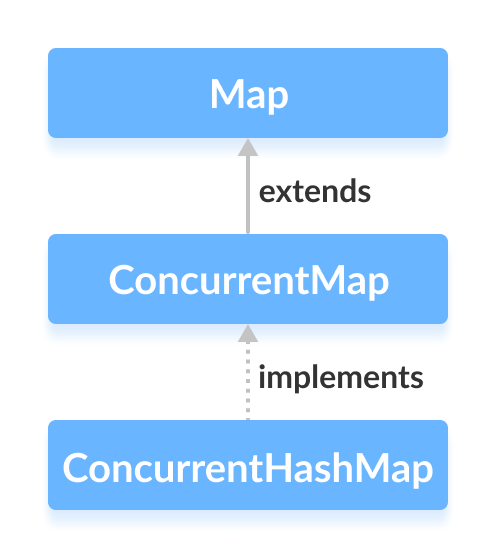java并发编程工具类JUC第八篇:ConcurrentHashMap

在之前的文章中已经为大家介绍了java并发编程的工具:BlockingQueue接口、ArrayBlockingQueue、DelayQueue、LinkedBlockingQueue、PriorityBlockingQueue、SynchronousQueue、BlockingDeque接口,本文为系列文章第八篇。
由于Java程序员常用的HashMap的操作方法不是同步的,所以在多线程环境下会导致存取操作数据不一致的问题,Map接口的另一个实现类Hashtable 虽然是线程安全的,但是在多线程下执行效率很低。为了解决这个问题,在java 1.5版本中引入了线程安全的集合类ConcurrentMap。

java.util.concurrent.ConcurrentMap接口是Java集合类框架提供的线程安全的map,这意味着多线程同时访问它,不会影响map中每一条数据的一致性。ConcurrentMap接口有两个实现类ConcurrentHashMap和ConcurrentSkipListMap,经常被使用的是ConcurrentHashMap,我们来重点关注它。
1.创建ConcurrentHashMap对象
通过下面的代码创建ConcurrentHashMap
// 创建容量为8,负载系数为0.6的ConcurrentHashMap
ConcurrentHashMap<Key, Value> numbers = new ConcurrentHashMap<>(8, 0.6f);
使用上面的代码,我们创建一个叫做numbers的ConcurrentHashMap对象。
- Key - 用于关联Map中每个元素的唯一标识
- Value - Map中每个元素,可以通过key值获取value
需要我们特别注意的是new ConcurrentHashMap<>(8, 0.6).
- capacity容量 - 第一个参数表示这个map的容量是8,也就是说这个对象可以存储8个键值对.
- loadFactor负载因子 - 这个map对象的负载因子是 0.6. 这意味着,每当我们的哈希表被填满60%的时候,条目就会被移动到一个新的哈希表,其容量大小是原来哈希表的两倍。
默认容量与负载因子
我们还可以通过下面的代码初始化一个ConcurrentHashMap对象,默认情况下capacity=16,loadFactor=0.75
ConcurrentHashMap<Key, Value> numbers1 = new ConcurrentHashMap<>();
2.ConcurrentHashMap常用方法
2.1. 向ConcurrentHashMap插入元素
put(K,V)- 向map中插入key/value 键值对数据putAll(map)- 把另一个map中的所有entries插入到当前的map中putIfAbsent(K,V)- 向map中插入key/value 键值对数据,如果该键值对的key在map不存在则插入数据,否则不做操作。
import java.util.concurrent.ConcurrentHashMap;
class Main {
public static void main(String[] args) {
// 创建ConcurrentHashMap 用于保存偶数
ConcurrentHashMap<String, Integer> evenNumbers = new ConcurrentHashMap<>();
// 使用put()方法插入数据
evenNumbers.put("Two", 2);
evenNumbers.put("Four", 4);
// 使用putIfAbsent()插入数据
evenNumbers.putIfAbsent("Six", 6);
System.out.println("偶数集合ConcurrentHashMap: " + evenNumbers);
//创建ConcurrentHashMap用于保存整数
ConcurrentHashMap<String, Integer> numbers = new ConcurrentHashMap<>();
numbers.put("One", 1);
// 使用putAll()插入数据
numbers.putAll(evenNumbers);
System.out.println("整数集合ConcurrentHashMap: " + numbers);
}
}
输出结果:
偶数集合ConcurrentHashMap: {Six=6, Four=4, Two=2}
整数集合ConcurrentHashMap: {Six=6, One=1, Four=-4, Two=2}
2.2.批量获取ConcurrentHashMap 元素
entrySet()- 获取 map中key/value 键值对集合keySet()- 获取map中所有的key的集合values()- 获取map中所有的value的集合
import java.util.concurrent.ConcurrentHashMap;
class Main {
public static void main(String[] args) {
ConcurrentHashMap<String, Integer> numbers = new ConcurrentHashMap<>();
numbers.put("One", 1);
numbers.put("Two", 2);
numbers.put("Three", 3);
System.out.println("ConcurrentHashMap: " + numbers);
// 获取 map中key/value 键值对集合
System.out.println("Key/Value mappings: " + numbers.entrySet());
// 获取map中所有的key的集合
System.out.println("Keys: " + numbers.keySet());
// 获取map中所有的value的集合
System.out.println("Values: " + numbers.values());
}
}
输出结果
ConcurrentHashMap: {One=1, Two=2, Three=3}
Key/Value mappings: [One=1, Two=2, Three=3]
Keys: [One, Two, Three]
Values: [1, 2, 3]
2.3. 获取指定Key元素的value值
get()- 获取指定key元素的value值,如果key不存在返回nullgetOrDefault()- 获取指定key元素的value值,如果key不存在返回一个指定的默认值
import java.util.concurrent.ConcurrentHashMap;
class Main {
public static void main(String[] args) {
ConcurrentHashMap<String, Integer> numbers = new ConcurrentHashMap<>();
numbers.put("One", 1);
numbers.put("Two", 2);
numbers.put("Three", 3);
System.out.println("ConcurrentHashMap: " + numbers);
// 获取指定key元素的value值,如果key不存在返回null
int value1 = numbers.get("Three");
System.out.println("Using get(): " + value1);
// 获取指定key元素的value值,如果key不存在返回一个指定的默认值
int value2 = numbers.getOrDefault("Five", 5);
System.out.println("Using getOrDefault(): " + value2);
}
}
输出结果
ConcurrentHashMap: {One=1, Two=2, Three=3}
Using get(): 3
Using getOrDefault(): 5
2.4.移除ConcurrentHashMap中的元素
remove(key)- 根据指定的key删除map中的元素,并将该元素返回remove(key, value)- 只有当map中存在指定的键映射到指定的值时,才会从map中删除条目,并返回一个布尔值。返回true表示删除成功,否则表示map中没有这个键值对。
import java.util.concurrent.ConcurrentHashMap;
class Main {
public static void main(String[] args) {
ConcurrentHashMap<String, Integer> numbers = new ConcurrentHashMap<>();
numbers.put("One", 1);
numbers.put("Two", 2);
numbers.put("Three", 3);
System.out.println("ConcurrentHashMap: " + numbers);
// 根据指定的key删除map中的元素,并将该元素返回
int value = numbers.remove("Two");
System.out.println("Removed value: " + value);
// 只有当map中存在指定的键映射到指定的值时,才会从map中删除条目,并返回一个布尔值。
boolean result = numbers.remove("Three", 3);
System.out.println("Is the entry {Three=3} removed? " + result);
System.out.println("Updated ConcurrentHashMap: " + numbers);
}
}
输出结果
ConcurrentHashMap: {One=1, Two=2, Three=3}
Removed value: 2
Is the entry {Three=3} removed? True
Updated ConcurrentHashMap: {One=1}
文章来源: zimug.blog.csdn.net,作者:字母哥哥,版权归原作者所有,如需转载,请联系作者。
原文链接:zimug.blog.csdn.net/article/details/115315693
- 点赞
- 收藏
- 关注作者


评论(0)